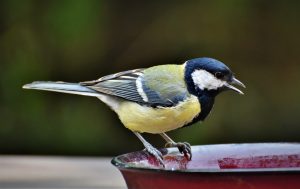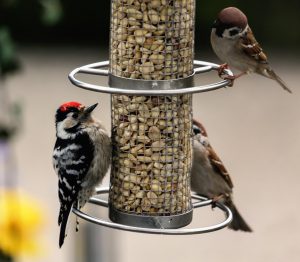Have you recently bought some new bird feeders and are yet to see any garden birds enjoying their treats? Or maybe you’re new to bird feeding and you seem to be waiting forever? Sometimes garden work can see a decline in bird visitors.
There are many reasons why birds don’t always use feeders, let’s have a look and see if we can find a remedy that gets our feathered friends flocking to your feeders.
Don’t get disheartened, it probably isn’t anything you’re doing wrong, it is probably the fault of Mother Nature, children, pets, or even the neighbours!
Birds will always choose natural sources if they are readily available. If there are insects, seeds, and berries in abundance, most birds will bypass your feeders and help themselves to nature’s supply, it is just the way it is.
Table of Contents
The Garden
To use feeders, first and foremost birds need to feel safe. Tables and stations should be in relatively sheltered positions and near to trees or shrubbery where the bird can retreat to at first signs of a predator. If a garden has little in the way of trees and shrubs, it won’t be very inviting to birds.
Climbers such as ivy, jasmine, honeysuckle, and clematis can be planted in pots and grow fast.
If you train them up trellis or fencing they will provide substantial cover and a place for birds to eat, shelter, and nest.
Similarly, bird boxes will attract the birds, they will try to source food as close by as possible and will rely on your feeders as a staple part of their brood’s diet.

Water
Birds need to bathe regularly to ensure their feathers remain in tip-top condition. A birdbath is an ideal spot for them to clean up or take a drink.
Hanging feeders close by is an open invitation to the birds to help themselves.
Offer the birds a varied diet
If you have 1-feeder with peanuts in and Mary next door has a variety of feeders stocked with sunflower hearts, nyjer seed, suet, and crushed peanuts, then most birds won’t give your feeder a second glance.
Providing a delicious selection needn’t be expensive. Lots of leftover scraps from the kitchen are tasty and have high nutritional value to the birds. Cake crumbs, porridge oats, fruit, and home-made suet balls should soon create a flurry at your bird tables.
Predators
Cats are a nightmare for the birds. That’s why the positioning of your bird feeders is very important. Give the bird somewhere secure to escape to if a cat shows up. High feeders also offer birds greater protection.
Gardens with pets are very off-putting for cats, even if it is a lazy old dog or a rabbit in a run. Birds will always remain on their guard. A new cat appearing in the neighbourhood that frequents your garden might spook the birds.
This doesn’t mean they will stay away, they may just need time to fully scope out the area to determine when and how it is safest to plunder your feeders.
Even harmless humans pose a risk to birds, most species feel threatened. Try to reposition the feeders into areas where there is less traffic.
Noise
Birds are easily spooked and any unexpected sound will make them fly for cover.
If yours is a busy garden, with lots of kid’s toys, apparatus, and little people happily playing, birds will be very wary.
They may watch from a distance and edge closer once everything goes quiet.
I find my feeders are less busy when the grandkids visit next door and hit the trampoline!
Again, the birds will watch from a vantage point for days, even weeks, until they feel secure and realise there is little or no threat.
Ground feeders
Remember not all birds can eat from hanging feeders, blackbirds, chaffinches, and some thrushes prefer ground feeding. You may attract birds onto your lawn with just a few mealworms in a dedicated tray.
Similarly, small agile birds use hanging feeders, try securing a feeder to a tree trunk or wall to invite other species.

Keep the feeders fresh
Dirty, smelly feeders will repel the birds, and those who attempt to eat from them may become ill.
Don’t overfill them initially, just a few seeds in the bottom until you have attracted some birds. Then remember to top them up regularly.
Final thoughts…
If you have ruled out all of the above, and birds still don’t come to your feeders, don’t despair and please don’t give up on our feathered friends.
Try regularly sprinkling seed on the ground beneath the feeders and hopefully they will be used to visiting the space. When the seed on the ground is no longer there, they may decide to use the feeders.
Keep re-filling your feeders, not all folks are so diligent and will let them sit empty as autumn turns to winter. This is when natural food is more scarce and you can encourage the birds to your garden.
Mostly, be patient. Just wait and I am sure in time you will be watching a flurry of activity at your feeders.
